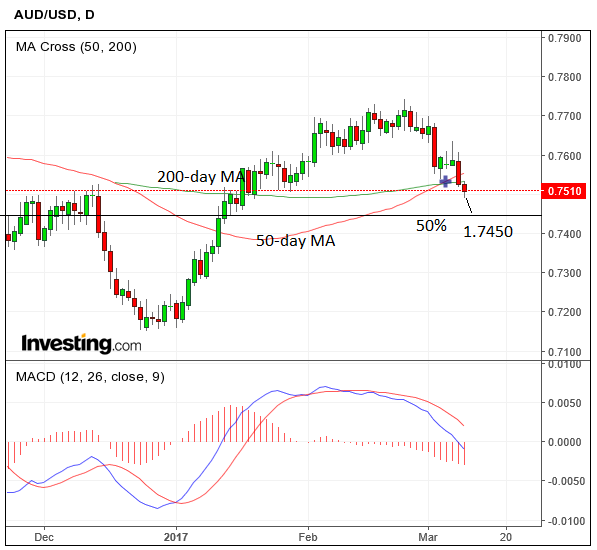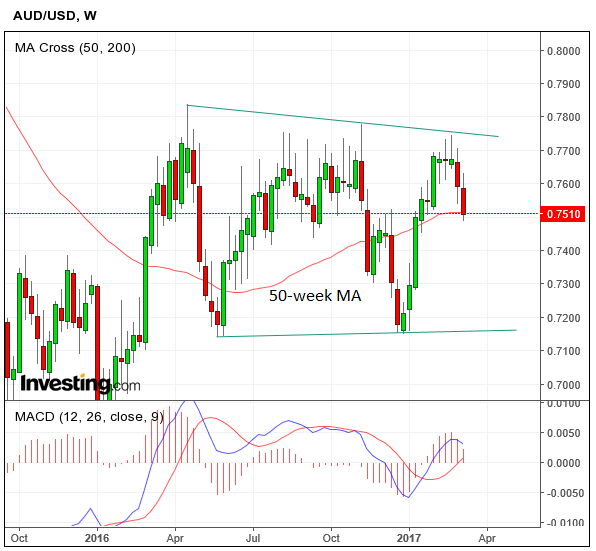Unexpected Rise in Housing Data Sparks Recovery in Australian Dollar

Positive economic data, showing a still-buoyant housing market, has sparked a recovery in AUD/USD after it reached support from a cluster of moving averages in the 0.75
An unexpected 0.5% rise in home loans helped support the Aussie as it suggested confidence amongst borrowers and a still active housing market.
The figure easily beat expectations of -1.0% and the 0.2% registered in the previous month.
The data will make it more difficult for the Reserve Bank of Australia (RBA) to cut interest rates for fear of making borrowing too cheap and accessible, and, if anything might encourage higher interest rates to stem overborrowing, especially in the housing bubble enclaves of Sydney and Melbourne.
A rise in interest rates would be positive for the Aussie Dollar as it would attract more foreign capital seeking higher returns.
The recovery is not revolutionary and does not yet mark a resumption of the uptrend but it does provide hope for bulls after the steep decline of recent weeks.
The Australian Dollar has reached a cluster of support levels which are expected to make further declines more difficult, and raise the possibility of a recovery.
The 50-week moving average (MA), 200-day and 50-day MA are all clustered slightly above the current trading level (of 0.7521 at time of writing).

Moving average are not just trend identifiers or market equilibrium levels, they are also dynamic levels of support and resistance which can provide inflection points for markets.
The AUD/USD exchange rate is therefore at a dramatic turning point in its trend – can bears force the rate lower breaking free from the drag of the MA’s or can bulls provide enough resistance to effect a rebound?
Commerzbank’s technical analyst Karen Jones seems to think the former.
“We look for a deeper sell-off towards 0.7450, the 50% retracement. Intraday rallies remain directly offered below 0.7645, the 20-day MA. Intraday Elliot Waves counts are negative,” said Jones in a note out this morning seen by Pound Sterling Live.
The current drama plays into broader themes of whether the sharp sell-off from the February highs is the beginning of a longer-term decline or simply a correction of the dominant uptrend. On this point Jones is also bearish:
On this point Jones is also bearish:
“Long term trend (1-3 months): Market has again failed ahead the 0.7836/50 2016 high and is neutral to negative.”

RBA Still Positive
The recent sell-off comes despite a relatively upbeat-neutral assessment by the Reserve Bank of Australia (RBA), who highlighted global growth prospects, a good outlook for commodities which are a major export for Australia and recent positive GDP data.
It also seems highly unlikely the central bank will cut interest rates anytime soon, as some had feared, due to stubbornly low inflation.
The Bank have no hints a cut was in the pipeline and were even uncharacteristically dismissive of the currency being too high, saying that it was a lot lower than in 2013.
Nevertheless, despite this, the AUD has sold off versus the Dollar, no doubt due mainly to Dollar appreciation on the back of recent increasing expectations the
Fed will raise rates in March. Clearly the widening monetary policy trajectory is a major factor, but the Aussie may also be reacting to negative news from China which could impact on its trade relationship in the longer-term.
Clearly, the widening monetary policy trajectory is a major factor, but the Aussie may also be reacting to negative news from China which could impact on its trade relationship in the longer-term.
China Addressing Air Pollution
China has one of the worst pollution problems in the world, and a massive 80% rise in air pollution in January brought this issue home.
The government is already trying to reduce pollution with various measures, but the one that most interest us is the preference for higher grade iron ore over more polluting lower grade ore, as highlighted in a recent report by RBC Economics' Sue Trinh.
The higher-grade ore comes from Brazil whilst Australia produces lower grade ore.
The change in preference is illustrated by recent trading stats which showed Australia proportion of total iron ore imports into China fell from 55% to 51%.
This was accompanied by a rise from 17% to 22% for Brazilian Ore.
It’s clear Beijing’s new policies encouraging use of higher grade ore are already impacting on Aussie iron ore exports.
This may be part of the reason for the steep sell-off since the February highs and if the trend continues then it could start to undermine the Australian dollar which gains much of its value from demand associated with sales of its exports abroad, especially iron ore which is the country’s largest export.
Chinese demand is likely to diminish in the near-term anyway, due to the re-stocking season ending.
The massive price appreciation in the commodity witnessed recently may also start to stall due to Beijing introducing new regulations limiting speculative futures trading on the Dalian exchange.




